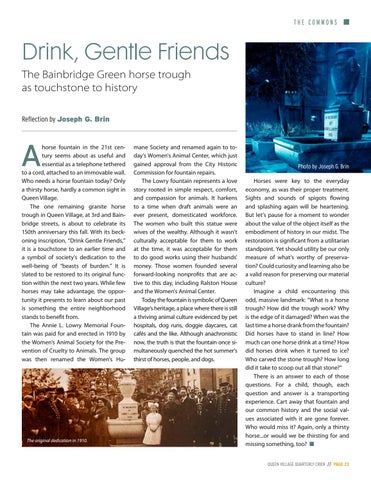the commons
Drink, Gentle Friends The Bainbridge Green horse trough as touchstone to history Reflection by Joseph G. Brin
A
horse fountain in the 21st century seems about as useful and essential as a telephone tethered to a cord, attached to an immovable wall. Who needs a horse fountain today? Only a thirsty horse, hardly a common sight in Queen Village. The one remaining granite horse trough in Queen Village, at 3rd and Bainbridge streets, is about to celebrate its 150th anniversary this fall. With its beckoning inscription, “Drink Gentle Friends,” it is a touchstone to an earlier time and a symbol of society's dedication to the well-being of “beasts of burden.” It is slated to be restored to its original function within the next two years. While few horses may take advantage, the opportunity it presents to learn about our past is something the entire neighborhood stands to benefit from. The Annie L. Lowry Memorial Fountain was paid for and erected in 1910 by the Women's Animal Society for the Prevention of Cruelty to Animals. The group was then renamed the Women's Hu-
The original dedication in 1910.
mane Society and renamed again to today's Women's Animal Center, which just gained approval from the City Historic Commission for fountain repairs. The Lowry fountain represents a love story rooted in simple respect, comfort, and compassion for animals. It harkens to a time when draft animals were an ever present, domesticated workforce. The women who built this statue were wives of the wealthy. Although it wasn't culturally acceptable for them to work at the time, it was acceptable for them to do good works using their husbands' money. Those women founded several forward-looking nonprofits that are active to this day, including Ralston House and the Women's Animal Center. Today the fountain is symbolic of Queen Village's heritage, a place where there is still a thriving animal culture evidenced by pet hospitals, dog runs, doggie daycares, cat cafés and the like. Although anachronistic now, the truth is that the fountain once simultaneously quenched the hot summer's thirst of horses, people, and dogs.
Photo by Joseph G. Brin Horses were key to the everyday economy, as was their proper treatment. Sights and sounds of spigots flowing and splashing again will be heartening. But let’s pause for a moment to wonder about the value of the object itself as the embodiment of history in our midst. The restoration is significant from a utilitarian standpoint. Yet should utility be our only measure of what’s worthy of preservation? Could curiosity and learning also be a valid reason for preserving our material culture? Imagine a child encountering this odd, massive landmark: “What is a horse trough? How did the trough work? Why is the edge of it damaged? When was the last time a horse drank from the fountain? Did horses have to stand in line? How much can one horse drink at a time? How did horses drink when it turned to ice? Who carved the stone trough? How long did it take to scoop out all that stone?” There is an answer to each of those questions. For a child, though, each question and answer is a transporting experience. Cart away that fountain and our common history and the social values associated with it are gone forever. Who would miss it? Again, only a thirsty horse...or would we be thirsting for and missing something, too? ■ Queen Village Quarterly Crier // PAGE 23







